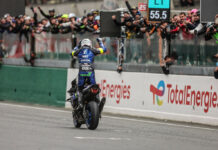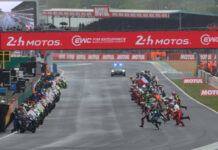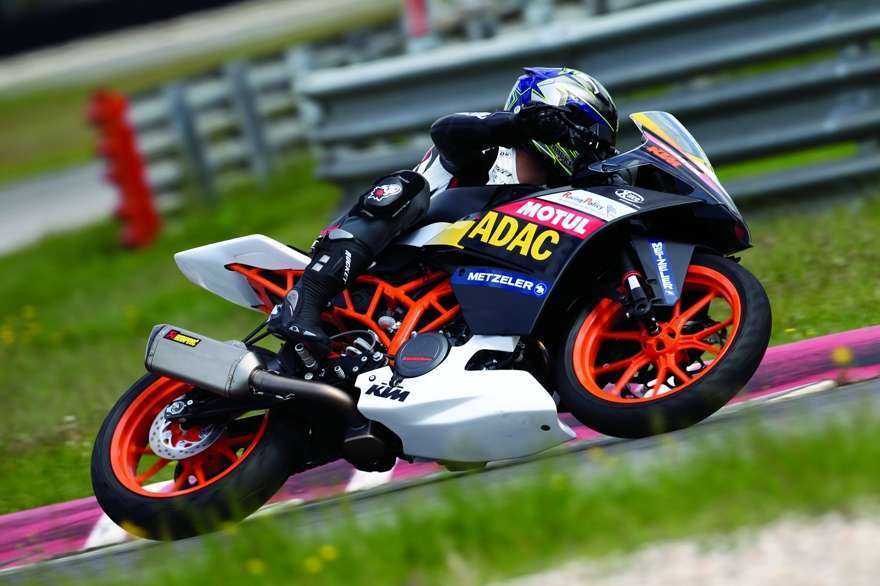To read more articles like this test ride featured in the July 2014 print issue, please subscribe to Roadracing World.
A Rational Alternative For New Racers: For KTM, “Ready To Race” Is More Than A Slogan
By Melissa Paris
It used to be that young racers started out on 50cc bikes on kart tracks, moved up to 80cc two strokes or 150cc four-strokes, started riding 125cc Grand Prix racebikes followed by 250cc Grand Prix racebikes and then transitioned to 600cc four-strokes. About 15 years ago it was normal for a 16 or 17-year old to be racing a Honda RS125 or a Yamaha TZ125.
But check out the annual Roadracing World Young Guns feature and it’s obvious that times have changed. Nowadays you’ll find that most kids make their first foray into full-sized road racing via some rendition of a Moto 3 machine (or a 125cc GP racebike if they were born before 1999 or so), usually followed by a big leap to a 600cc Supersport machine. Which is why it’s now common to see 13-year-olds and 14-year-olds racing 360-pound, 600cc production-based racebikes capable of reaching 170 mph on a fast racetrack.
There are several reasons for this. First, tuning and keeping a 125cc two-stroke or 250cc four-stroke GP racebike running right requires some level of technical expertise, and if a parent isn’t a good mechanic, that means paying somebody else to do it.
Second, the smallest bike anybody can race at an AMA Pro National is now a 600. So if a kid has racing aspirations that include reaching the big show when they turn 16 and can get an AMA Pro license, they’ve got to have experience before then, on a 600. And those first two reasons have influenced the third reason, a decline in the popularity and entries in GP classes suitable for young riders on purpose-built 125cc two-stroke or 250cc four-stroke racebikes. With fewer riders competing on those bikes, a kid on a Moriwaki MD250H, for example, has more trouble finding the type of competition that leads to improvement.

As recently as 2010, there was a plan to add a Moriwaki MD250H class for 12-year-olds and a 650cc Twin class for 14-year-olds to AMA Pro events. The plan came apart when 13-year-old Peter Lenz died in a freak crash on the warm-up lap for a USGPRU race held during the MotoGP weekend at Indianapolis Motor Speedway that year, and the general-interest news media had a field day. Never mind that the kids weren’t actually racing at 165 mph around the famed banked oval as claimed on TV! Track owners freaked out, AMA Pro Racing opted out, and the idea that anybody under the age of 16 should be able to race during an AMA Pro weekend died as well.
What it all means is that there are no opportunities to race any sort of Grand Prix racebike beyond club events in the U.S., and the parents of many racer kids think they’ve got to put them on a 600 as soon as possible—even if the kid can’t put both feet on the ground when sitting on the bike.
It’s different in Europe, and KTM thinks it should be different in the U.S. as well.
KTM worked closely with officials from the ADAC Junior Cup— which runs as a class in the Superbike IDM International German Championship—to create a new bike to replace the two-stroke machines that the series has used since its inception in 1993. The ADAC Junior Cup is designed for new riders ages 13 to 21 and is where many famous Grand Prix riders started, including Moto3 stars Jack Miller, Sandro Cortese and Phillip Oettl; Moto2 star Thomas Luthi; and 250cc GP pioneer Katja Poensgen.
Enter the KTM RC 390, a new small-displacement sportbike from the Austrian manufacturer, sold in both a street version as well as a racing version.
The racing version is called the RC 390 Cup; it sells for €6,500 (about $8900 U.S.) in Germany and riders can enter the entire eight-race series for €2490 (about $3411 U.S.). The series offers up to €70,000 (about $95,900 U.S.) in prize money and support as well as a guaranteed Red Bull MotoGP Rookie Cup tryout for the top three finishers in the Championship. With this program, KTM and the ADAC Junior Cup have removed nearly every barrier to entry for aspiring road racers.

The RC 390 and RC 390 Cup are both based closely on the already successful 390 Duke streetbike. (KTM also supports the KTM 390 Duke Cup in France and KTM 200 Duke Cup in Italy, and produces the KTM RC 250R Moto3 racebike.) Both versions of the RC 390 feature a 375cc liquid-cooled, fuelinjected single-cylinder engine with a Bosch engine management system and 46mm throttle body, a forged piston, Nikasil cylinder plating, double overhead cams and four valves. Bore is 89mm and stroke is 60mm, with a compression ratio of 12.6:1. The crankcases are designed to keep sump oil away from the rotating crankshaft, reducing parasitic power losses, and unlike powerplants adapted from motocross machines, the engine is designed to be operated continuously at high rpm, and it comes with an electric starter.
The engine in the standard RC 390 street version makes 44 horsepower. The RC 390 Cup version is actually detuned to 38 horsepower using a throttle-limiting block, making the power delivery more mellow.
The engine is carried in a powder- coated lightweight tubular steel chassis; the swingarm is cast aluminum alloy and a sharkfin lower chain guard is standard. Rake is 23.5 degrees, trail is 88mm and wheelbase is 1340mm (52.7 inches) with an adjustment range of 1325mm to 1355mm (52.2 to 53.3 inches). Wheels are cast aluminumalloy, the front measuring 3.00 x 17 inches and the rear measuring 4.00 x 17 inches.
To match KTM’s Ready To Race philosophy, the RC 390 Cup also comes equipped with fully adjustable (rebound, compression and spring preload) WP suspension front and rear.
Making it easier to fit a growing young rider, there are also adjustable rearset footpegs and foot controls, as well as adjustable clipon handlebars and brake and clutch levers (each with its own guard). The ability to easily switch from standard street shift (up for higher gears) to GP shift (down for higher gears) is built in. Braking comes from a single 300mm disc and a four-piston caliper in the front and a 230mm disc with a single-piston caliper in the rear. The standard ABS has been removed from the RC 390 Cup version to reduce weight, and the Cup bike comes with full race bodywork, complete with crash sliders on each side of the fairing, a built-in oil catch pan and a taller windscreen. The exhaust silencer is made by Akrapovic.
The RC 390 Cup weighs about 305 pounds.
But of course what really matters is how the RC 390 Cup is to ride.

When I climbed aboard, my immediate impression was that the ergonomics were perfect for me. At 5’5” most sport bikes leave me on my very tip toes with a somewhat long reach to the handlebars as well. The RC 390 Cup was the perfect compromise between a 125cc GP racebike and a full-sized 600cc sportbike. With a seat height of 820mm (32.3 inches) I could comfortably reach the ground and the reach to the bars was just right for a somewhat sporty riding position without being too stretched out. With RC 390 Cup riders meant to be between the ages of 13 and 21, the bike should be a pretty good fit for most.
Pulling out onto the Autodromo Dell’Umbria course I was ready to get down to business. After two laps to get acquainted with the circuit, it was time to see how the RC 390 Cup performed. After hearing that a mechanical throttle stop left the racebike with six less horsepower than the streetbike and that the bike weighed nearly twice as much as the 125cc Grand Prix machine I started racing on, I wondered how much fun it would be to ride. But I was pleasantly surprised to find the power plenty adequate to keep things exciting.
(To be honest I would have rather ridden it in its unrestricted version, but not having had the chance, I have to give KTM and the ADAC Junior Cup folks the benefit of the doubt regarding the decision to reduce power and make power delivery more mellow.)
The engine pulls nicely from the bottom straight through until the shift indicator light comes on at about 14,200 rpm. Compared to a two-stroke GP bike, the power characteristics make the RC 390 Cup leaps and bounds easier for a new rider to get going on.
I found the gearing to be a bit short, never getting below third gear on the relatively small circuit, and I would be curious to see how it would perform on a full-sized track. The transmission seemed to be relatively smooth and not as clunky as the tranmissions in some bikes at this price point often are. It did jump back into fourth gear after I shifted into fifth one time and I overheard another journalist complain of the same, so I’ll be curious to see how the transmission holds up over an entire season of racing, especially in the hands of young racers.
As far as handling goes, I was pretty impressed with the balance of the bike. No single part seemed to overpower another, which made it hard to pick out one single glaring problem. In current trim, I think the weakest link would most likely be the Metzeler street tires. There was a definite limit to how hard you could lean on the front before it began to give a strong warning. I’d like to see how the chassis worked with grippier, race-oriented tires, but I get that the idea is to not burn through a lot of tires. I did try a few different settings on the front, but to be honest the limit that I continued to bang into was the capability of the front tire.
All told, given that the purpose of the RC 390 Cup is to create a suitable platform for Junior Cup riders to hone their craft, I’d say it’s a pretty big success. The bike is just plain fun to ride. Its not intimidating in the least but at the same time, has enough capability to be ridden pretty hard. With the power being limited in the way that it is, I doubt that set-up will be as crucial as it can be on other machines. In this way, I think it will be a great way for young racers to hone their skills and focus on developing their race craft.
I imagine that with 30 kids lined up on the grid, this KTM should create some incredible racing that will not only be fun to participate in but will be a blast to watch.
KTM North America’s plan to is find a racing series in the U.S. that’s willing to take on the RC 390 Cup project, and I hope they succeed. Superbike Shootout 2015 maybe?
Then all would I need is a counterfeit birth certificate so I could sign myself up…
To read more articles like this test featured in the July 2014 print issue, please subscribe to Roadracing World.






